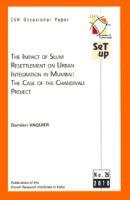Indian Special Economic Zones: The Difficulties of Repeating China’s Triumph
About the Author:
Claudia Astarita is Adjoint Professor of Politics of China at John Cabot University, of Asian Studies al LUISS University, and International Relations Analyst (India) at Centre for Military and Strategic Studies (CeMiSS), in Rome. She obtained her Ph.D. from Hong Kong University in early 2010 and has worked as a researcher there as well as at the French Centre for the Study of Contemporary China (CEFC; UMIFRE n°18 Unité Mixte MAE-CNRS) from 2006 to 2010. Her main research interests include China’s political and economic development, Chinese and Indian Foreign policies, East Asian regionalism and regional economic integration. Her works have been published by Chinese, Indian, American, English and Italian publishers. In Italy, Claudia Astarita regularly contributes with articles on Asian political, economic and social issues to several newspapers and magazines such as Il Secolo XIX, Panorama and EAST.
Summary:
This paper attempts to contribute to ongoing research on Special Economic Zones (SEZs) by discussing the characteristics, prospects and limitations of the SEZ experiment in India. The paper is divided in three sections. The first one deals with the origins of SEZs, going back to the first examples of Asian SEZs and deepening the analysis with a comparison of Chinese and Indian experiments. Grounding on this juxtaposition, the paper highlights the reasons why SEZs have been important strategies in both China and India and the role played by the two governments in shaping the characteristics of their ‘SEZ policy’.
The second section takes a critical look at India’s SEZ policy. Grounding on field work outputs, Indian SEZs’ strengths and weaknesses are assessed focusing on three different aspects: old and new SEZs; single-sector and multi-sector zones; and original support and planning backed by private or public developers. To provide an all-embracing evaluation of Indian SEZs strategy, these themes are approached from two different perspectives: the one of developers, and the ones of national and foreign firms investing in local SEZs.
The third section explores European reactions to Indian SEZs strategy, elaborating on a series of interviews with European diplomatic representatives based in New Delhi. After giving an account of the approaches of four EU countries towards SEZs -Spain, France, Germany and Italy-, this paper continues to identify, with the help of collected data, the reasons why the interests of foreign investors towards these zones have not generated the kind of response that was anticipated.
In conclusion, an assessment of the current status of Indian SEZs is offered, as well as a few suggestions on how to improve their rate of success, effectiveness, and foreign investments attractiveness.
Contents:
Indian Special Economic Zones: The Difficulties of Repeating China’s Triumph
Introduction
Asian SEZ: historical roots and economic implications
SEZs in China and India: A Comparison
The difficulties of SEZs implementation
SEZs characteristics and impact. The Indian experience
Indian SEZ strategy: old and new SEZs
Indian SEZ strategy: single-sector and multi-sector SEZs
Indian SEZ strategy: public and private developers
Special Economic Zones: European Experiences Before and After the Global Financial Crisis
Spain
France
Germany
Italy
Conclusion
Bibliography
Annex 1: List of Operational SEZ of India
Annex 2: List of Formal Approvals Granted Under the SEZ Act, 2005
Annex 3: List of Valid In-Principle Approvals
- In :CSH
- Year :2013
- Pages :118









